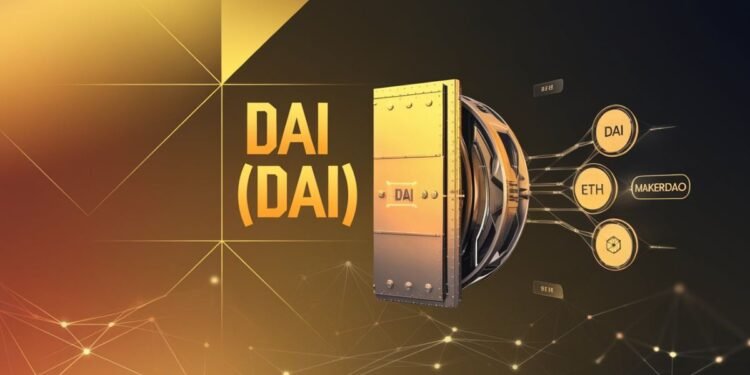Dai (DAI) has demonstrated remarkable price stability in 2024, maintaining its peg to the U.S. dollar through a decentralized, crypto-backed system governed by MakerDAO. As one of the most prominent decentralized stablecoins, Dai has become a key player in decentralized finance (DeFi) applications, offering users a reliable means to engage in lending, borrowing, and other financial activities with minimal volatility. With its robust governance mechanisms and growing liquidity, Dai remains a cornerstone in the evolving DeFi ecosystem.
Dai’s Stability Mechanisms and Market Trends in 2024
Dai (DAI) stands apart from centralized stablecoins like USDC and USDT by maintaining. Governed by MakerDAO, this structure ensures that no central authority can control the stablecoin, making Dai an essential component of the decentralized finance (DeFi) ecosystem. In 2024, Dai has continued to prove its resilience, maintaining stability despite broader market volatility, thanks to its over-collateralization and decentralized governance.
The Role of MakerDAO in Dai’s Stability
MakerDAO plays a central role in maintaining Dai’s stability. Through its decentralized governance, MakerDAO allows MKR token holders to vote on important protocol parameters, such as collateral types, stability fees, and liquidation ratios. Users lock up assets like Ethereum (ETH) and other approved cryptocurrencies in Maker Vaults to generate Dai, ensuring that each DAI token is over-collateralized. This over-collateralization helps mitigate the risk of volatility in the collateralized assets.
MakerDAO’s system is designed to react to fluctuations in Dai’s price. If Dai falls below $1, the stability fee (the interest rate charged on generated Dai) is raised, encouraging users to repay their debts and reduce Dai supply. If Dai rises above $1, the stability fee is lowered to encourage more Dai generation, increasing supply and lowering the price.
Potential Table: Dai’s Collateral Types and Stability Mechanisms
| Collateral Type | Liquidation Ratio | Stability Fee |
|---|---|---|
| Ethereum (ETH) | 150% | Variable |
| Wrapped Bitcoin (WBTC) | 125% | Variable |
| Other Cryptocurrencies | 135%–170% | Variable |
This decentralized governance system ensures that Dai remains stable, even during periods of market turmoil, as the system can adjust the supply and demand of Dai through governance decisions.
Dai Price Trends and Market Performance in 2024
In 2024, Dai has continued to maintain its stability, with its price rarely fluctuating more than a few fractions of a cent from its $1 peg. The stability mechanisms of over-collateralization and community governance have been key factors in ensuring this performance, allowing Dai to remain a preferred stablecoin within the DeFi ecosystem.
Key events such as increased DeFi adoption and regulatory developments have impacted the liquidity and usage of Dai, but its decentralized nature and robust stability mechanisms have ensured that it continues to perform well. Dai’s liquidity in DeFi platforms like Aave and Compound remains strong, as users favor its stability and decentralized backing over centralized alternatives.
Potential Checklist: Key Factors Maintaining Dai’s Stability in 2024
- Over-collateralization of assets
- Governance by MakerDAO
- Integration into major DeFi platforms
- Stability fees to control volatility
Dai’s ability to maintain its peg throughout 2024 highlights its importance as a decentralized, stable alternative in a volatile market.
Dai’s Role in Decentralized Finance (DeFi) Ecosystem
As decentralized finance (DeFi) continues to grow, Dai (DAI) has become integral to its ecosystem. Dai’s decentralized, crypto-backed stablecoin model has made it a trusted form of collateral across numerous DeFi applications. In lending protocols, liquidity pools, and cross-chain operations, Dai plays a pivotal role by offering a stable asset for borrowers and lenders. Its unique ability to maintain a stable value, while being governed by the MakerDAO protocol, solidifies its importance in DeFi, where users seek stability in a highly volatile market. In 2024, Dai’s presence in DeFi remains robust, with increased adoption and liquidity across platforms.
Dai in DeFi Lending and Borrowing Protocols
Dai is widely used as collateral in DeFi lending platforms such as Aave, Compound, and MakerDAO. In these protocols, users can deposit Dai as collateral to access loans without needing traditional financial intermediaries. For example, MakerDAO’s system allows users to lock up Ethereum or other approved assets in Maker Vaults to generate Dai, ensuring a decentralized borrowing process. Similarly, platforms like Aave and Compound also allow users to borrow Dai or use it as collateral to lend out other assets.
The key benefits of using Dai in lending include:
- Decentralization and censorship resistance: Dai is not controlled by any central authority, making it ideal for trustless lending.
- Stable value for collateral: Unlike volatile assets, Dai’s peg to the U.S. dollar provides a stable base for borrowing and lending.
- Broad integration with major DeFi platforms: Dai is accepted in many DeFi applications, increasing its liquidity and usability.
H3: Dai’s Integration into DeFi Liquidity Pools
In addition to lending, Dai is crucial in DeFi liquidity pools, where users provide Dai as liquidity to earn interest or trading fees. These liquidity pools are essential for decentralized exchanges (DEXs) and yield farming protocols. On platforms like Uniswap and SushiSwap, users can stake Dai into liquidity pools, enabling decentralized trading pairs and boosting liquidity for decentralized markets. This process not only allows users to earn returns but also strengthens Dai’s role in DeFi infrastructure.
Stablecoin liquidity, like that provided by Dai, is vital for maintaining efficient operations within decentralized exchanges. It ensures users have access to stable trading pairs and minimizes the risk of significant price fluctuations in more volatile assets. Dai’s cross-chain functionality further enhances its appeal, allowing it to be used across different blockchain networks.
Further Reading:
In 2024, Dai (DAI) continues to uphold its reputation as a stable and decentralized asset within the DeFi ecosystem. Its unique structure, governed by MakerDAO, enables secure and reliable operations across lending, borrowing, and liquidity pools. The decentralized nature of Dai, coupled with its strong integration into major DeFi platforms, makes it a vital component for users seeking stability in a volatile crypto market. As DeFi grows, Dai’s role is likely to expand, providing more opportunities for decentralized financial innovation.





